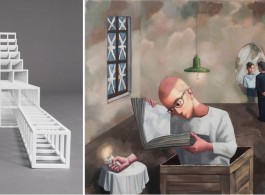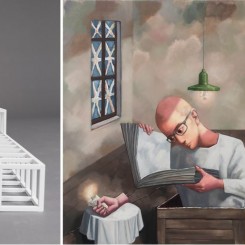Pace Beijing is pleased to present a joint exhibition Sol LeWitt and Zhang Xiaogang, opening to the public on 28 September and running through to 19 November. Featuring a series of over 20 new paintings by renowned Chinese artist Zhang Xiaogang, the exhibition marks his return to Beijing after four years. Zhang’s new works will be positioned in a spiritual dialogue with sculptures and wall drawings by the American master Sol LeWitt. Sol LeWitt and Zhang Xiaogang will mark the first comprehensive exposition of LeWitt’s representative works in China.
The ideas of ‘Conceptual Art’ introduced by Sol LeWitt in the1960s sought to set art free from the shackles of formalism, and his radical practice had a profound and widespread influence on the artists of his generation and beyond. In order to uphold the principal and constitutional idea of ‘perception’, the visual language used by LeWitt was reduced to a fundamental basis, creating varying sequential structures with basic geometric shapes, thus radically eliminating the uncontrolled variable, namely his personal feelings, from the artistic practice. He further subverted the traditions of art practice by producing a series of wall drawings, which were in fact executed by his assistants following LeWitt’s detailed guidelines. By separating the process of creation from the actual production, the artist broke away from the constraints and limitations set by technical skills, therefore reaching a higher level of conceptualism.
While LeWitt’s work extracts and purifies the physical into the conceptual, Zhang’s work opens up a psychological inner world, which is more metaphorical in comparison. The major difference stems from the fact that the American master was mostly concerned with art itself. However, the issues that Zhangis facing, as China’s most representative contemporary artist, are much more complex, multi-dimensional and intrusive in nature. Intertwining history with reality, nations with cultures, collective memories with private memories, the rich imagery in his work could not survive in a vacuum-of abstract space, but is able to reconstruct and renew itself within the emotional and imaginative construct of private memories. In his new body of work, Zhang dramatically changes his visual direction in regard to the construction of the inner space. The implied text and imagery in his previous works are turned into concrete visual symbols. Objects re-appearing in his artworks, such as a door, a window, a mirror, a cabinet and a drawer, divide the rooms of memories into multiple layers, and formally become the archive of memories in Zhang’s new body of work.
Each section of theSol LeWitt and Zhang Xiaogang exhibition is constructed in such a way as to carry a different artistic orientation. However, be it an intellectually abstract construction or a metaphorical room in a spiritual sense, their significance is beyond amere physical existence. This stark contrast leads to a strong collision in the juxtapositionof the exhibits. A translucent wall dividing the works of Zhang Xiaogang and LeWitt helps to blur the boundary between the exhibited pieces, generating a visual clash on one hand and a harmonious, conceptual co-existence on the other.
In our globalised world, the discussion on the traditional and the modern, the conceptual and the physical, the abstract and the figurative, is no longer afierce battle on the grounds of art history. LeWitt’s pioneering ideas became the source of unlimited inspiration in artistic thinking and since 1960s have been liberating artists from the constraints of technical skills. Zhang regained his courage to paint under the influence of such liberation. Ableto enjoy the freedom of artistic expression, his work returned to a pure personal fascinationwith art. Artists who have been set free would first need to confront their own personal history and depict their inner space.
Sol LeWitt (1928 – 2007, USA), a prolific New York artist in the post-war era, is often regarded as a pioneer of minimalism in America, along with artists such as Donald Judd. In the late 1960s, he propelled the minimalism as a mode of artistic expression to a metaphysical level by proposing that ‘the idea becomes a machine that makes the art.’ LeWitt established a vocabulary of forms by using the most basic geometric shapes as standard components of his conceptual art. LeWitt also created a series of wall drawings by providing his assistants with a set of instructions to follow. Such an act overturned the traditional idea of art making, liberating artists from being bound by technical skills. Since 1965, LeWitt has been extensively collected and exhibited by a number of major museums and galleries, with collections and exhibitions covering over 1,100 works ranging from works on paper, to wall drawings, photography, and 3D installations made from geometric shapes.
Zhang Xiaogang(1958 –, China) belongs to a small group of contemporary artists who rose to international prominence in the early days of Chinese contemporary art. Described by the renowned art critic Li Xianting as ‘the epitome of the Chinese contemporary artist’, Zhang is known for his lyricism as well as highly liberal refinement, reconstruction, fusion and renewal of the stereotypical depictions of history and reality, culture and society, collective and private memories. His art describes the history of a generation while infusing it with a new life. Zhang’s art belongs not only to the Chinese but also to the world of Asia, where transitions from tradition to modernity, with all the accompanying torment, are taking place. The continent must face the inevitable questions arising from numerous historical, cultural, traditional and memory-related issues. The transitions also serve as an important demonstration and narration of the locality in a globalized society.
Since 2008, Pace Beijing has introduced works of influential Western artists to China, including Pablo Picasso, David Hockney, Mark Rothko, James Turrell, and Donald Judd. This joint exhibition once again brings remarkable figures of American contemporary art to China, hoping to establish a deeper connection with the local cultural ecology through artistic exchange.
The exhibition runs through to 19 November 2016.


